1993 PONTIAC GRAND-AM wheel
[x] Cancel search: wheelPage 237 of 306
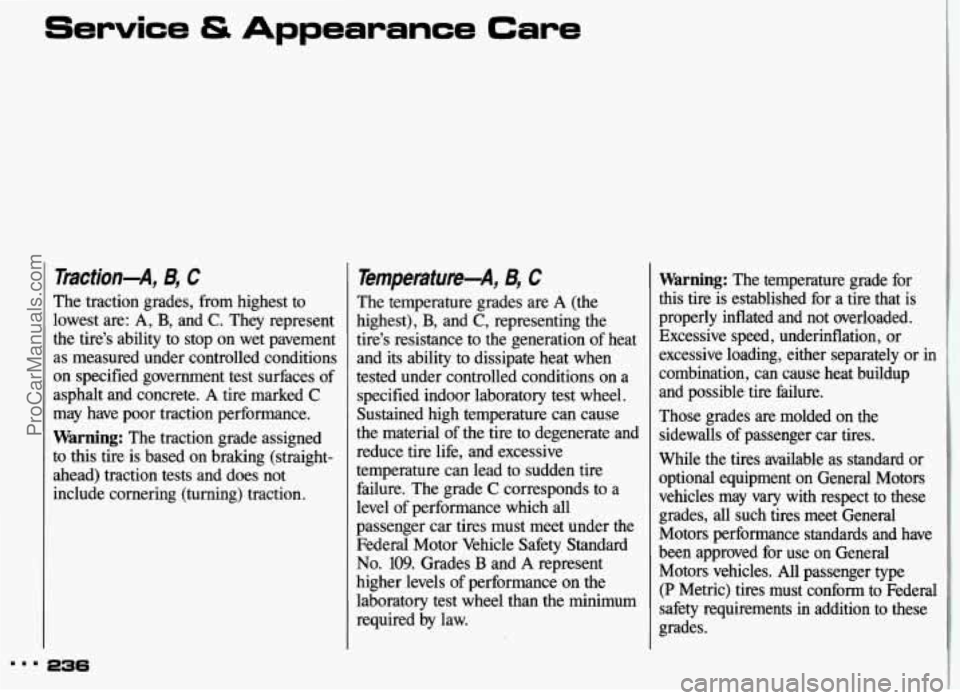
Traction-A, B, C
The traction grades, from highest to
lowest are:
A, B, and C. They represent
the tire’s ability to stop on wet pavement
as measured under controlled conditions
on specified government test surfaces of
asphalt and concrete.
A tire marked C
may have poor traction performance.
Warning: The traction grade assigned
to this tire is based on braking (straight-
ahead) traction tests and does not
include cornering (turning) traction.
Temperature-A, B, C
The temperature grades are A (the
highest),
B, and C, representing the
tire’s resistance to the generation of heat
and its ability to dissipate heat when
tested under controlled conditions on a
specified indoor laboratory test wheel.
Sustained high temperature can cause
the material of the tire to degenerate and
reduce tire life, and excessive
temperature can lead to sudden tire
failure. The grade
C corresponds to a
level of performance which all
passenger car tires must meet under the
Federal Motor Vehicle Safety Standard
No. 109. Grades B and A represent
higher levels of performance on the
laboratory test wheel than the minimum required by law.
Warning: The temperature grade for
this tire is established for a tire that is
properly inflated and not overloaded. Excessive speed, underinflation, or
excessive loading, either separately or in
combination, can cause heat buildup
and possible tire failure.
Those grades are molded on the sidewalls of passenger car tires.
While the tires available as standard or
optional equipment on General Motors
vehicles may vary with respect to these
grades,
all such tires meet General
Motors performance standards and have
been approved for use on General Motors vehicles. All passenger type
(P Metric) tires must conform to Federal
safety requirements in addition to these
grades.
ProCarManuals.com
Page 238 of 306

Wheel Alignment and
Tire Balance
The wheels on your vehicle were
aligned and balanced carefully at
the
factory to give you the longest tire life
and best overall performance.
In most cases, you will not need to have
your wheels aligned again. However, if
you notice unusual tire wear or your
vehicle pulling one way or the other, the
alignment may need to be reset. If you
notice your vehicle vibrating when
driving on a smooth road, your wheels
may need to be rebalanced.
Wheel Replacement
Replace any wheel that is bent, cracked
or badly rusted. If wheel nuts keep
coming loose, the wheel, wheel bolts,
and wheel nuts should be replaced. If
the wheel leaks air out, replace it
(except some aluminum wheels, which
can sometimes be repaired).
See your
Pontiac dealer if any of these conditions
exist.
Your dealer will know the kind of wheel
you need.
Each new wheel should have the same
load carrying capacity, diameter, width,
offset, and be mounted the same way as
the one it replaces.
If you need to replace any of your
wheels, wheel bolts, or wheel nuts,
replace them
only with new GM
original equipment parts. This way, you
will be sure
to have the right wheel,
wheel bolts, and wheel nuts for your
Pontiac model.
CAUTION I
Using the wrong replacement
I. wheels, wheel bolts, or wheel
nuts
on your vehicle can'be
dangerous.
It could affect the
braking and handling
of your
vehicle, make your tires lose air
and make you lose control. You
could have a collision in which you
or others could be injured. Always
use the correct wheel, wheel bolts,
and wheel nuts for replacement.
237
ProCarManuals.com
Page 239 of 306
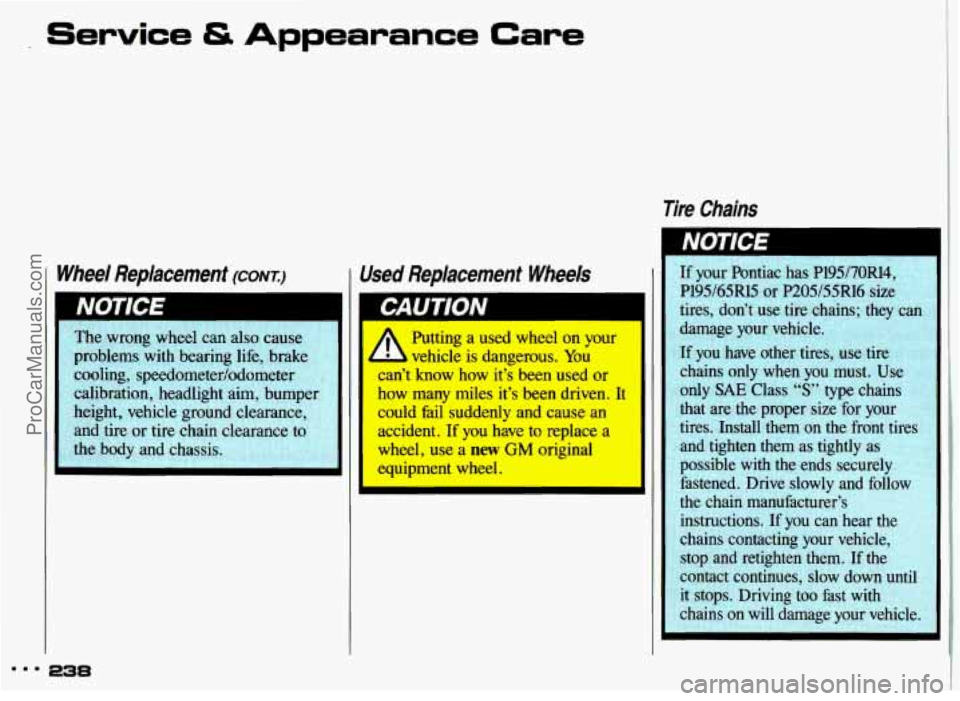
Service & Appearance Care
Tire Chains
...
Wheel Replacement (CONT.)
The wrong wheel can also cause
problems with bearing life, brake cooling, speedometer/odometer
calibration, headlight aim, bumper
height, vehicle ground clearance,
and tire or tire chain clearance to
the body and chassis.
I
238
Used Replacement Wheels
Putting a used wheel on your
L vehicle is dangerous. You
I cs know how it’s been used or
how many miles it’s been driven. It
-mid fail suddenly and cause an
accident. If you have
to replace a
\wheel, use a
new GM original If your Pontiac has P195/70R14,
P195/65R15
or P205/55R16 size
tires, don’t use tire chains; they can
damage your vehicle.
If you have other tires, use tire
chains only when you must. Use
only
SAE Class “S” type chains
that are
the proper size for your
tires. Install them
on the front tires
and tighten them as tightly as
possible with the ends securely fastened. Drive slowlv and follow
r’
the chain manufacturer’s
instructions. If you can
h
chains contacting your v
stop and retighten them. If the
contact continues, slow down until
it stops. Driving too fast with
chains on will damage your vehicle.
ProCarManuals.com
Page 245 of 306
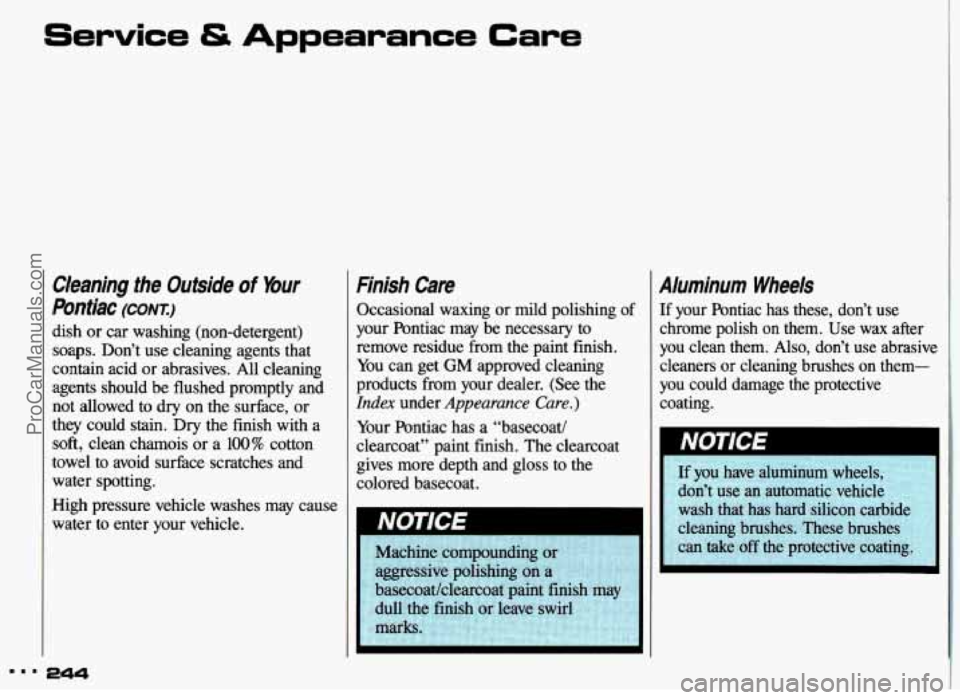
Service & Appearance Care
Cleaning the Outside of Your
pbntiac (CONT)
dish or car washing (non-detergent)
soaps. Don’t use cleaning agents that
contain acid or abrasives. All cleaning
agents should be flushed promptly and
not allowed to dry on the surface, or
they could
stain. Dry the finish with a
soft, clean chamois or a 100% cotton
towel to avoid surface scratches and water spotting.
High pressure vehicle washes may cause
water to enter your vehicle.
244
Finish Care
Occasional waxing or mild polishing of
your Pontiac may be necessary to
remove residue from the paint finish.
You can get
GM approved cleaning
products from your dealer. (See the
Ida under Appearance Care.)
Your Pontiac has a “basecoat/
clearcoat” paint finish. The clearcoat
gives more depth and gloss to the
colored basecoat.
Aluminum Wheels
If your Pontiac has these, don’t use
chrome polish on them. Use wax after
you clean them.
Also, don’t use abrasive
cleaners or cleaning brushes on them-
you could damage the protective
coating.
ProCarManuals.com
Page 253 of 306
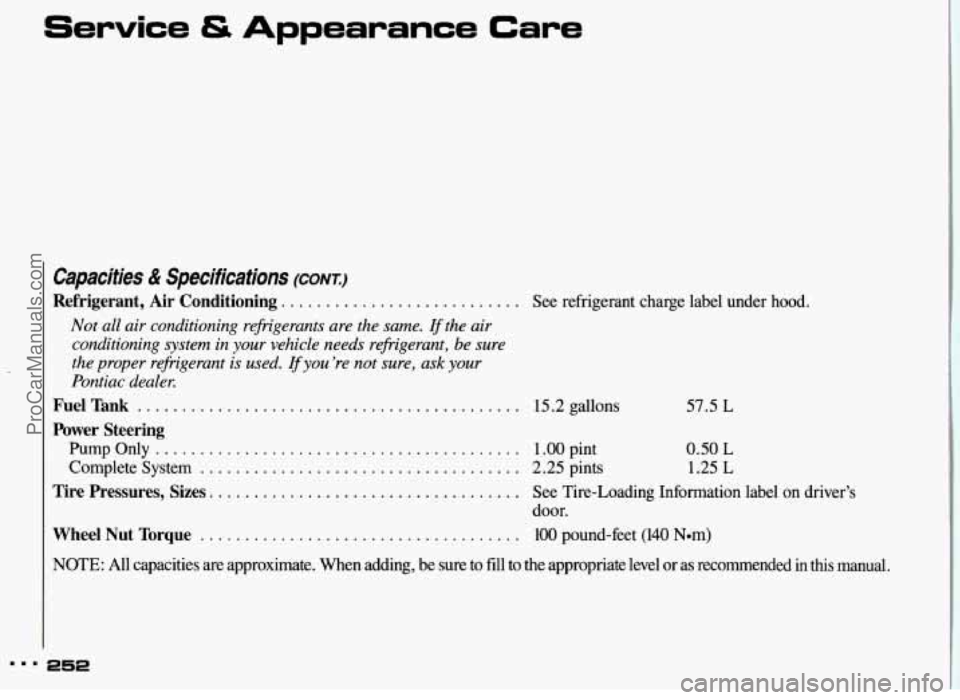
Service & Appearance Care
Capacities & Specifications (CONT.:)
Refrigerant, Air Conditioning. .......................... See refrigerant charge label under hood.
Not all air conditioning refrigerants are the same. If the air
conditioning system in
your vehicle needs refngerant, be sure
the proper refrigerant is used.
If you’re not sure, ask your
Pontiac dealer.
Fuel Tank ......................................... 15.2 gallons 57.5 L
Power Steering
Pump Only ......................................... 1 .OO pint 0.50 L
Complete System .................................... 2.25 pints 1.25 L
Tire Pressures, Sizes. .................................. See Tire-Loading Information label on driver’s
Wheel Nut Torque .................................... 100 pound-feet (140 Nom)
door.
NOTE: All capacities are approximate. When adding, be sure to fill to the appropriate l\
evel or as recommended in
this manual.
... 252
ProCarManuals.com
Page 267 of 306
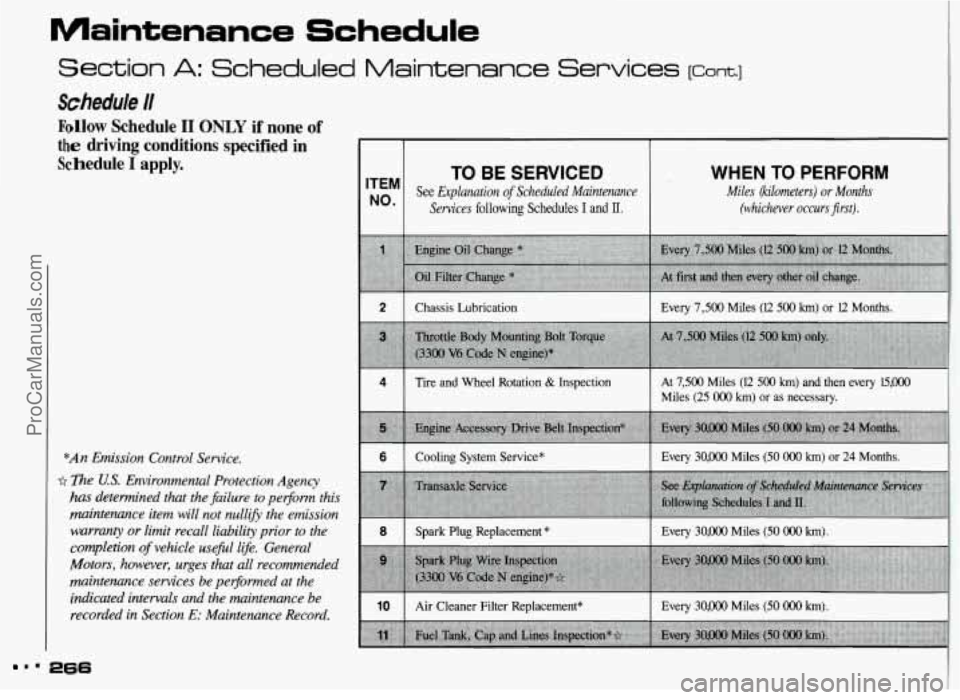
Maintenance Schedule
Section A: Scheduled Maintenance Services lcont.1
Schedule I1
Follow Schedule I1 ONLY if none of
the driving conditions specified in
Schedule
I apply.
*An Emission Control Sewice.
fi The US. Environmental Protection Agency
has determined that the failure to per$orm this
maintenance item
will not nullifL the emission
warranty or limit recall liability prior to the
completion
of vehicle usefil life. General
Motors, however, urges that
all recommended
maintenance services be per$ormed at the
indicated intervals and the maintenance be recorded in Section
E: Maintenance Record.
TO BE SERVICED
See &planation of Scheduled Maintenance
Services following Schedules I and II.
ITEM
No'
WHEN TO PERFORM
Miles (kilometers) or Months
(whichever occurs first).
2 I Chassis Lubrication 1 Every 7,500 Miles (E 500 km) or 12 Months.
Tire and Wheel Rotation
& Inspection At 7,500 Miles (12 500 km) and then every l5,000
Miles (25 000 km) or as necessary.
6 I Cooling System Service* I Every 30,000 Miles (50 000 km) or 24 Months.
8 I Spark Plug Replacement * I Every 30,000 Miles (50 000 km).
10 I Air Cleaner Filter Replacement* I Every 30,000 Miles (50 000 lan).
' 266
ProCarManuals.com
Page 269 of 306
![PONTIAC GRAND-AM 1993 Owners Manual Maintenance Schedule
Section A: Scheduled Maintenance Services [cant.]
Explanation of Scheduled Maintenance Services
Below are explanations of the services listed in Schedule I
and Sched PONTIAC GRAND-AM 1993 Owners Manual Maintenance Schedule
Section A: Scheduled Maintenance Services [cant.]
Explanation of Scheduled Maintenance Services
Below are explanations of the services listed in Schedule I
and Sched](/manual-img/50/58387/w960_58387-268.png)
Maintenance Schedule
Section A: Scheduled Maintenance Services [cant.]
Explanation of Scheduled Maintenance Services
Below are explanations of the services listed in Schedule I
and Schedule II.
The proper fluids and lubricants to use are listed in
Section D. Make sure whoever services your vehicle uses
ITEM
NO. SERVICE
1 Engine Oil and Filter Change-Always use SG
Energy Conserving 11 oils of proper viscosity.
The “SG” designation may be shown alone or
in
combination with others, such as “SG/CC,”
“SG/CD” or
“SF, SG, CC,” etc. If you have the
2.3L Quad OHC or a Quad
4 engine, the preferred
viscosity for your vehicle’s engine is
SAE 5W-30.
However, you can use
SAE 1OW-30 if it’s going to
be
0°F (-18°C) or above. If you have the 3300 V6
engine, the preferred viscosity for your vehicle’s
engine is
SAE 1OW-30. However, you can use SAE
5W-30 if it’s going to be 60°F (16°C) or below. these. All parts should be replaced and all necessary repairs
done before you or anyone else drives the vehicle.
NOTE: To determine your engine’s displacement and code,
see the
Index under Engine Identijication.
ITEM
NO.
2
3
4
SERVICE
Chassis Lubrication-Lubricate the transaxle shift
linkage, parking brake cable guides, underbody
contact points and linkage. Lubricate the front and
rear suspension, steering linkage and fuel filler
door and striker plunger.
Throttle
Body Mounting Bolt Torque (3300 V6
Code N engine)*-Check the torque of the
mounting bolts and/or nuts.
Tire and Wheel Rotation and Inspection-For
proper wear and maximum tire life, rotate your
tires following the instructions in this manual. See
the
Index under llres, Inspection & Rotation.
Check the tires for uneven wear or damage. If you
see irregular or premature wear, check the wheel
alignment. Check for damaged wheels
also.
* An Emission Control Service.
i? The US. Environmental Protection Agency has determined that the failure to pe@orm this maintenance item will not nullifL the emission warranty or
limit recall liability prior to the completion
of vehicle useful life. General Motors, however, urges that all recommended maintenance sem’ces be
peflormed at the indicated intervals and the maintenance be recorded in Section E: Maintenance Record.
268
ProCarManuals.com
Page 276 of 306

Section C: Periodic Maintenance Inspections
Listed below are inspections and services which should be perfo\
rmed at least twice a year (for instance, each spring and fall).
You should let your GM dealer’s service department or other qualified service center do these jobs: Make sure any necessary
repairs are completed at once.
L
INSPECTION
OR SERVICE
Steering, Suspension
and Front-Wheel-Drive
Axle Boot and Seal
Inspection
Exhaust System
Inspection
Throttle Linkage
Inspection
Brake System
Inspection
WHAT SHOULD BE DONE I
Inspect the front and rear suspension and steering system for \
damaged, loose or missing parts,
signs
of wear, or lack of lubrication. Inspect the power steering lines and hoses for proper
hookup, binding, leaks, cracks, chafing, etc. Clean and then in\
spect the drive axle boot seals for damage, tears or leakage. Replace seals if necessary.
Inspect the complete exhaust system. Inspect the body near the \
exhaust system. Look for broken,
damaged, missing or out-of-position parts
as well as open seams, holes, loose connections, or
other conditions which could cause a heat build-up in the floor pan or could let exhaust fumes
into the vehicle. See the
Idex under EnRine Exhaust.
Inspect the throttle linkage for interference or binding, and for damaged or missing parts.
Replace parts as needed.
Inspect the complete system. Inspect brake lines and hoses for \
proper hookup, binding, leaks,
cracks, chafing, etc. Inspect disc brake pads for wear and rot\
ors for surface condition. Also
inspect drum brake linings for wear and cracks. Inspect other brake parts, including drums,
wheel cylinders, calipers, parking brake, etc. The parking brake is self-adjusting and no manual
adjustment is required,
You may need to have your brakes inspected more often if your driving
habits or conditions result in frequent braking.
NOTE:
A low brake fluid level can indicate worn disc brake pads which \
may need to be
serviced. Also, if the brake system warning light stays on or comes on, something may be wrong
with the brake system. See the
Index under Brake System Warning Light. If your anti-lock brake
system warning light stays on, comes on or flashes, something may be wrong with the anti-lock
brake system. See the
Index under Anti-Lock Brake System Warning Light.
275
ProCarManuals.com